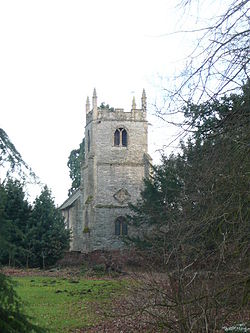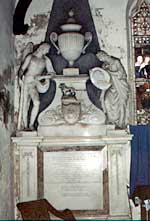Well, I am back from my latest jaunt into Derbyshire - and, this time, Nottinghamshire. The highlights included a walk in glorious autumn sunlight in Chee Dale - a dale I'd never even heard of, but a ravishingly beautiful one - and another good haul from the never-failing Wirksworth Bookshop: Sylvia Townsend Warner's The Corner that Held Them, J.G. Farrell's A Girl in the Head (which I've never read) and Pevsner's Nottinghamshire. It's the first edition (1951, price three shillings and sixpence) of what was only the second in the Buildings of England series, and hence it is comfortably small enough to slip into the pocket. It was to come in very handy as we made our way towards Southwell Minster...
My cousin was keen to take a look at Maplebeck, a village she had visited before years ago, and the Pevsner listing of a nearby, even smaller village, Winkburn, was intriguing enough to make us stop there and investigate. Winkburn has a manor house and church right next to each other - the house briefly visible from the road some way outside the village, but not the church; and when we arrived both had disappeared amid the trees. What was there was a large yard full of gleaming heavy machinery and the offices of some kind of contracting firm. Deep rural quiet, a cloudy Midland sky, and not a soul in sight, until a man in a white van drew up to ask us to move the car. From him we learnt that there was a path through the trees that would, despite appearances, lead to the church and the house.
The trees were a mix of tall deciduous standards, all in their autumn colours, and dense plantings of laurel and holly and holm oak, and between them they did a very effective job of keeping house and church well hidden. Until suddenly, there was Winkburn Hall - a solid, elegant but unpretentious house of the early18th century - and, after a while, the church of St John of Jerusalem, Winkburn, also came into view, right by the house but more deeply hidden among the greenery. 'Platonic England, house of solitudes,/ rests in its laurels and its injured stone,/ replete with complex fortunes that are gone,/ beset by dynasties of moods and clouds...' (as Geoffrey Hill put it).
The church is small, unspoilt, essentially Norman, its tiny sunless graveyard almost overgrown, moss-greened baroque headstones just topping the lush grass. John Piper would have loved it. A plain, dark interior that feels as if little has changed since the family - the Burnells - inhabited (for nine generations) the big house. Their 'complex fortunes that are gone' are memorialised in a sober Jacobean monument (William Burnell, kneeling in conventional prayer) and a very much more flamboyant memorial to the last of the line, D'Arcy Burnell, who died in 1774. On either side the pedestal of a large urn stand Death, in the guise of a rather beautiful, underdressed young man holding an inverted torch, and Fame, in female form, holding a portrait profile of D'Arcy Burnell, Esquire. His long epitaph ends with a couplet from Pope's Essay on Man: 'A wit's a feather, and a chief a rod:/ An honest man's the noblest work of God.'
I'm tempted to say 'Only in England', but of course there are similarly well hidden, richly atmospheric and rewarding house-and-church ensembles to be found embedded among the byways of Normandy, and far beyond. Yet there is something peculiarly English about the atmosphere of a place - almost a non-place but for these two survivors - like Winkburn. And we, uniquely, have Pevsner to guide us toward them.
On a grander, more glorious scale, Southwell Minster did not disappoint. I hadn't been there for a good many years and had forgotten just how beautiful and astonishing the carved stonework of the chapter house - Pevsner's Leaves of Southwell (King Penguin, 1945) - and the screen/pulpitum is. The very ideal of Gothic craftsmanship - exquisitely wrought but spirited and mischievous, naturalistic, richly human and individual.
Then, on the final day, to Haddon Hall, my favourite Derbyshire house, 'the English castle par excellence', as Pevsner puts it, 'the unreasonable dream castle of those who think of the Middle Ages as a time of chivalry and valour and noble feelings'. Here all was as I remembered it, apart from a bizarre object plonked in the middle of one of the rooms. Clad in a grubby, hideously coloured textile (a kind of Seventies mustard yellow) and resembling a disassembled delta-wing aircraft, this was, I learnt, a sofa designed by Zaha Habib. How anyone would contrive to sit on it I have no idea; why anyone would buy it and put it on display, still less.
As for butterflies, the visit began with three Tortoiseshells and ended with two Speckled Woods, just as the sun came out, at Haddon Hall.
[The curious image at the top is a photograph of a sconce in Winkburn church, with a patch of baroque wall painting behind.]
Subscribe to:
Post Comments (Atom)




Ah, Zaha Hadid, the Camila Batmanghelidjh of architecture.
ReplyDeleteSpot on Recusant!
ReplyDelete